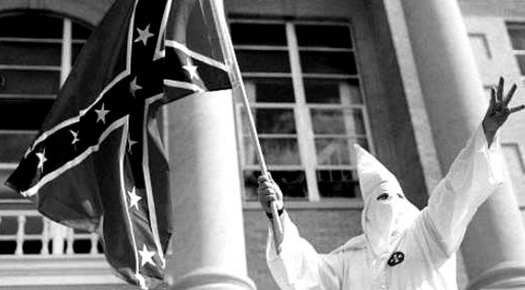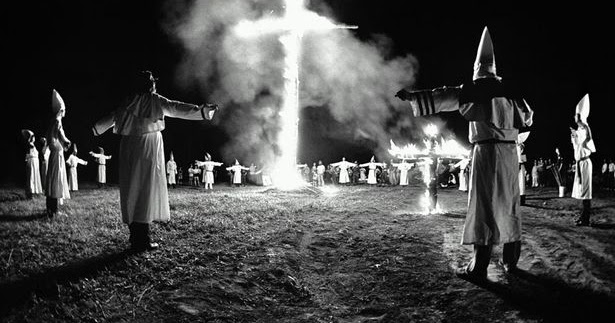
The Ku Klux Klan is attempting a comeback by reshaping itself for a new era. The white supremacist organization, which was born in the defeated South during the late 1860s in the aftermath of the Civil War, is now 150 years old. Even though it has been in decline for several decades, Klan leaders claim the group is still alive and dreams of rising once again.
Watchdog groups estimate total membership at only a few thousand nationwide, with some even scoffing at the idea of a Klan resurgence, as there is no single Klan today and various sects continue to disagree over both philosophy and strategy. Still, existing leaders of the Ku Klux Klan say the current political scenario in the United States is panning out just the way they wanted – as a nationalist, us-against-them, mindset that has deeply impacted a vast cross section of the nation.
Reportedly, Klan members still meet by the dozens under starry skies to set ablaze crosses in the dead of the night. As a matter of fact, Ku Klux Klan pamphlets have showed up across suburban neighbourhoods from the South to the Northeast in recent months.
These recruitment fliers, attacking blacks, Jews and transgender people, have been reported across Central New York, including places like Syracuse and Liverpool. People found such literature on their cars, describing America’s oldest hate group as the sole organization that cares for the rights of whites.
“We are in every state, you will not be alone anymore,” one flier, featuring a picture of a hooded Klansman, stated. “Please join before it's too late.”
Similar messages of white pride have also appeared in California, Indiana, Georgia, Kentucky, Michigan, Louisiana, North Carolina and South Carolina.
According to law enforcement officials, it is not illegal for anyone, including the Ku Klux Klan, to circulate fliers, as the First Amendment protects the rights of all Americans. While police departments in most cities, where such literature has been found, have received complaints, no arrests have still been made.
Clearly unwelcome to its opponents, some independent Klans are apparently merging with larger interest groups to build strength and regain the numbers they have lost over time.
In a series of interviews with The Associated Press, Klan leaders shared how stopping or restricting immigration, a dream of the organization dating back to the 1920s, is more of a cause now than ever before. They also said membership has gone up during President Barack Obama’s second term in office.
Seeking membership with the Klan is as easy as filling out an online form as long as the applicant is white and Christian. Members are free to visit an online store if they wish to purchase one of the organization’s trademark white cotton robes for $145 even though most of them prefer splurging on the $165 satin version.
While the Ku Klux Klan gained notoriety during much of the last century by terrorizing minorities across America, its leaders now present a public front that is more venomous than violent. Leaders of several sects all said they have rules condemning violence apart from self-defense and even watchdog groups agree that the Ku Klux Klan has toned itself down after many of its members were imprisoned for carrying out deadly beatings, arson attacks, shootings and bombings.
“While today’s Klan has still been involved in atrocities, there is no way it is as violent as the Klan of the ‘60s,” said Mark Potok of Southern Poverty Law Center (SPLC), an advocacy group that tracks activity by groups it considers extremist. “That does not mean it is some benign group that does not engage in political violence.”
According to Klan leaders, most of today’s sects are small in terms of membership and operate independently, as they continue to disagree over such issues as whether to hold public rallies, wear the organization’s trademark robes in colours other than white or associate with neo-Nazis. It is still unclear how many members Ku Klux Klan counts today since sects refuse to reveal that information but leaders insist their adherents are in the thousands among scores of local groups, commonly referred to as Klaverns.
“Most Klan groups I talk to could hold a meeting in the bathroom in McDonald’s,” said Chris Barker, imperial wizard of Loyal White Knights of the Ku Klux Klan in Eden, North Carolina. As for his Klavern, he said, “Right now, I’m close to 3,800 members in my group alone.”
The Anti-Defamation League (ADL), a Jewish protection group that screens Klan activity, described Barker’s sect as the most active Klavern today but estimated it has no more than 200 members. According to the ADL, total Klan membership nationwide is approximately 3,000.
SPLC estimated the Ku Klux Klan has roughly 190 chapters nationally with no more than 6,000 members. If true, this would be a mere shadow of the Klan’s estimated two million to five million members during the 1920s.
“The idea of unifying the Klan like it was in the ‘20s is a persistent dream of the Klan, but it’s not happening,” Potok said.

Founded by six former Confederate officers only months after the end of the Civil War, the Ku Klux Klan initially seemed more like a college fraternity that offered odd titles and ceremonial robes to its officers. But soon, its members were terrorizing freed blacks and ruthlessly assaulting or killing them as they attempted to regain control over the defeated confederacy. Congress finally outlawed the organization in 1871. It appeared as though the Klan had died or at least relegated to history until World War I, when it once again resurrected as waves of migrants arrived from Europe and elsewhere, and became even more active while National Association for the Advancement of Colored People opposed the Jim Crow laws through the 1920s. Millions of white Christians joined the Ku Klux Klan at this point, including influential community leaders such as bankers and lawyers. It was not long before the momentum started to decline however and best estimates placed membership at approximately 40,000 by the 1960s, when the American Civil Rights Movement reached its peak. Klan members were convicted of using murder as a weapon against equality in states such as Alabama and Mississippi.
Brent Waller, Imperial Wizard of United Dixie White Knights in Mississippi, said, “Stopping immigration — not blocking minority rights — is the Klan’s No. 1 issue today.”

Despite trying to reshape itself, the Ku Klux Klan has not stepped away from its age-old rituals. At sunset on a warm Saturday in April, Klan members met in northwest Georgia to form a huge circle in the middle of a field and set fire to a cross and a Nazi swastika.
“White power!” they chanted in unison. “Death to the ungodly! Death to our enemies!”
Photo Credits: Business Insider
